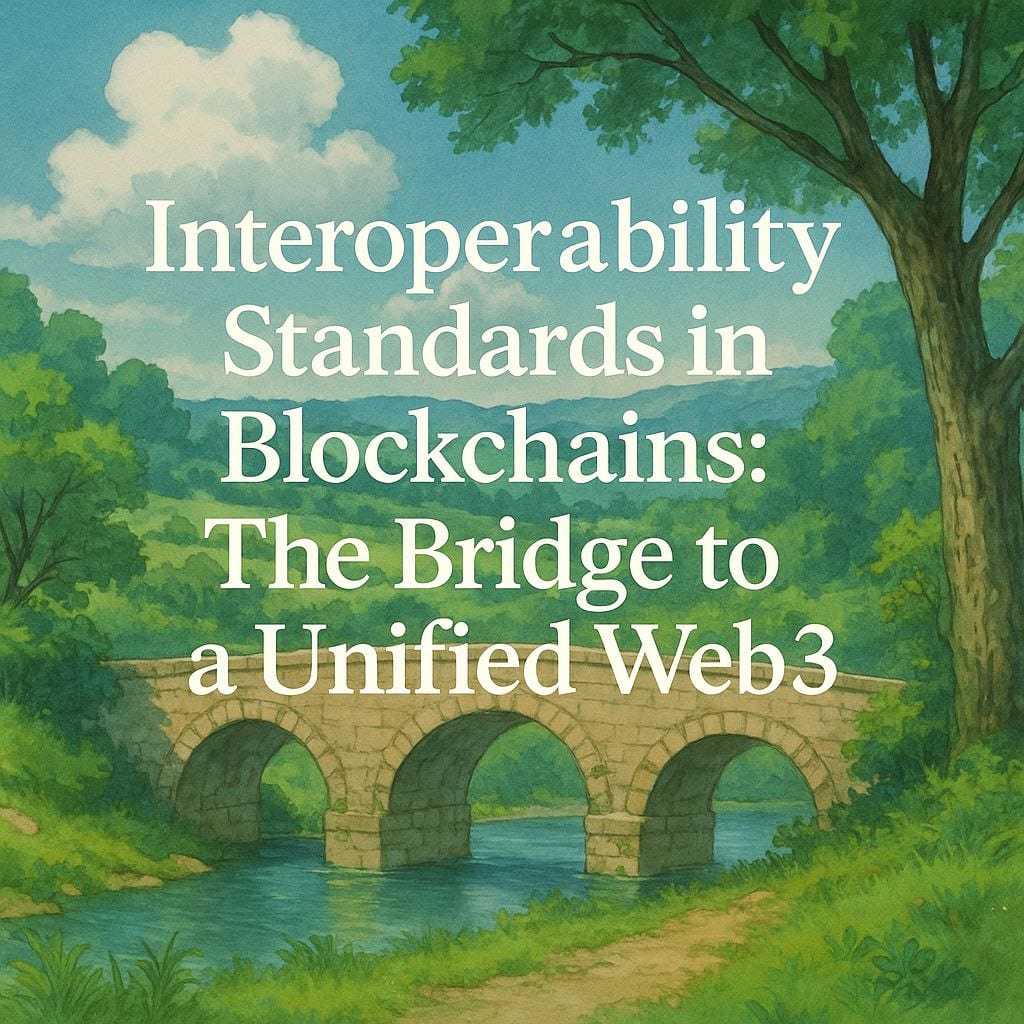Interoperability Standards in Blockchains: The Bridge to a Unified Web3

This article breaks down four leading interoperability standards—LayerZero, Axelar, Wormhole, and Hyperlane—highlighting their architectures, trade-offs, and practical use cases. Special focus is given to Mitosis, which leverages Hyperlane’s permissionless and sovereign stack to power its cross-chain liquidity layer. We also outline key limitations in trust models, security consistency, and developer complexity. And end by asking: What should the shared standard for interoperability in Web3 truly look like?
Preamble: Why Interoperability Standards Matter
Blockchains have traditionally functioned as isolated ecosystems—each with its own consensus mechanisms, execution environments, and token economies. However, the true potential of Web3 unfolds in a network of interconnected blockchains, where users, assets, and data flow freely and seamlessly. Interoperability standards are crucial for realizing this vision.
Without them, every cross-chain application requires Individualized development which is riskier, slower, and prone to fragmentation. With standardized interoperability, developers can build on a shared foundation of assumptions and tools, enabling scalable, secure, and seamless multi-chain applications.
This need for interoperability is driven by several factors:
- The proliferation of Layer-2 scaling solutions (rollups, sidechains)
- The rise of application-specific chains (appchains)
- The push to break down “walled garden” ecosystems
- The demand for composability across diverse DeFi protocols
This article discusses four leading interoperability standards shaping the future of Web3: LayerZero's OFT, Axelar's Interchain standards, Wormhole's messaging protocol, and Hyperlane's sovereign interoperability stack. Each offers a unique philosophy, design trade-offs, and real-world use cases that are critical for both builders and users.
1. LayerZero's OFT Standard (Omnichain Fungible Tokens)
Design Philosophy
LayerZero approaches interoperability as a foundational messaging layer. Its OFT (Omnichain Fungible Token) standard allows tokens to function as native assets across multiple chains, eliminating wrapped token models that often fragment liquidity and degrade user experience.
How It Works
- Ultra Light Node (ULN): A gas-efficient endpoint that verifies block headers instead of full blocks.
- OFT Token Logic: Tokens are burned on the source chain and minted as native equivalents on the destination chain.
- Off-Chain Oracles & Relayers: Independent parties are used to verify and relay messages, with a separation of roles to reduce collusion risk.
Trade-Offs
- Native Asset Abstraction vs. Trust Assumptions: OFTs improve composability but depend on semi-trusted oracles and relayers.
- Gas Efficiency vs. Security Considerations: Efficient but requires rigorous security design to avoid header manipulation.
Use Cases
- Omnichain DEXs: Radiant Capital uses OFTs to support seamless asset trading across chains.
- Cross-chain DAOs: PancakeSwap employs OFTs for unified voting across blockchains.
- Multichain NFTs: MintDAO utilizes OFTs for NFTs with stateful properties that react to events on different chains.
2. Axelar Interchain Token & GMP Standards
Design Philosophy
Axelar is a full-stack interoperability protocol built using the Cosmos SDK. It supports generalized message passing (GMP) and secure token mobility, treating the interchain as a first-class citizen.
How It Works
- General Message Passing (GMP): Enables smart contracts on one chain to trigger arbitrary functions on another.
- Interchain Token Service (ITS): Supports native token transfers without wrapping.
- Validator-Based Security: A decentralized validator set secures all cross-chain communication.
Trade-Offs
- Security vs. Latency: Axelar emphasizes robust validator consensus, slightly increasing latency for added security.
Use Cases
- Multi-chain Stablecoins: e-Money uses Axelar to move stablecoins across chains.
- Cross-chain Gaming/DeFi: Squid builds interchain user experiences with Axelar GMP.
- DAO Coordination: Uniswap utilizes Axelar for DAO actions across multiple ecosystems.
3. Wormhole Messaging Protocol
Design Philosophy
Wormhole functions as a general-purpose cross-chain messaging layer, known for early Solana integration and institutional support. It focuses on speed and broad connectivity.
How It Works
- Guardians Network: A decentralized validator network (Guardians) observes and attests to cross-chain messages.
- Core Messaging Layer: Handles arbitrary payload transfers.
- Relayers: Transmit Guardian-verified messages to destination chains.
Trade-Offs
- Speed & Coverage vs. Centralization Risk: Guardian validation is fast but introduces trust assumptions due to the relatively small validator set.
Use Cases
- Cross-chain NFTs & Metaverse Assets: Portal enables NFTs and gaming assets to move across chains.
- Interchain Lending/Borrowing: Folks Finance supports cross-chain collateralized loans.
- Unified Digital Identity: Releap Protocol bridges social identity and graphs across chains.
4. Hyperlane: Sovereign Interoperability
Design Philosophy
Hyperlane pioneers sovereign interoperability, allowing projects to define their own security models for cross-chain messaging. It promotes permissionless deployment, giving developers full control over how, where, and why messages are validated.
How It Works
- Permissionless Deployment: Hyperlane can be deployed to any chain without approval.
- Interchain Accounts: Chain-agnostic accounts that can control logic across other chains.
- Interchain Security Modules (ISMs): The core innovation allowing customizable validation methods:
- Quorum-based
- Oracle-based
- Light client proofs
Trade-Offs
- Flexibility vs. Complexity: Developers get unmatched control but must manage security consistency across ISMs.
Use Cases
- Appchains with Custom Logic: Mukutu Safe uses ISMs to implement tailored cross-chain security.
- Cross-chain Governance: Hyperlane Nexus lets DAOs govern assets across chains while preserving sovereignty.
- Rollup Bridges with Local Logic: Rollups use Hyperlane to integrate custom bridge security into their architecture.
Mitosis and Hyperlane: A Strategic Integration
Mitosis, a modular cross-chain liquidity protocol, utilizes Hyperlane’s permissionless interoperability stack to manage liquidity and execution across various chains. The ability to deploy Hyperlane anywhere and define security logic per connection is key to Mitosis’s architecture, allowing it to:
- Support fast, composable liquidity routing
- Maintain modular design across L2s and appchains
- Avoid reliance on monolithic or wrapped bridge systems
This permissionless, modular messaging stack forms the cross-chain backbone of Mitosis—letting it coordinate liquidity, pricing, and swaps across chains without central trust assumptions.
Ethereum Foundation & Open Intents
The Ethereum Foundation has recognized Hyperlane's sovereignty model as foundational to the emerging Open Intent Framework, which aims to let users express "what they want" (intents) rather than how to do it. Hyperlane powers the cross-chain messaging and coordination infrastructure that lets different solvers fulfill these intents across chains, trustlessly and modularly.
Conclusion
While current interoperability protocols like LayerZero, Axelar, Wormhole, and Hyperlane represent significant progress, they still face limitations:
- Security Trade-offs: Different protocols prioritize security in different ways, leading to varying levels of trust assumptions. Some rely on centralized validators or relayers, which can be potential points of failure.
- Complexity: Implementing and managing interoperability solutions can be complex, requiring significant development effort and expertise. This can hinder wider adoption.
- Scalability: As the number of connected chains and transaction volumes increase, some protocols may face scalability challenges, leading to congestion or higher fees.
- Standardization: The lack of universal standards can lead to fragmentation and compatibility issues between different interoperability solutions.
- Latency: Cross-chain communication can introduce latency, which can be a bottleneck for applications requiring real-time interactions.
These limitations highlight the ongoing challenges in achieving truly seamless and secure interoperability in Web3.
The big question:What should the shared standard for interoperability in Web3 truly look like?
Sources and related content



Comments ()